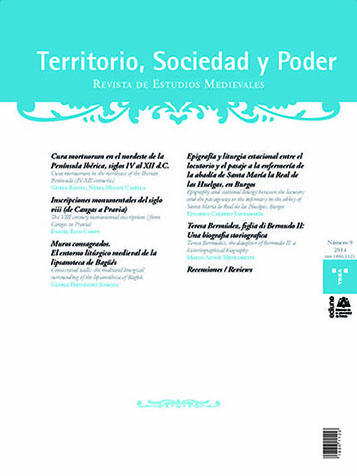Resumen
Resumen: La iglesia de los Santos Julián y Basilisa de Bagüés, en la provincia de Zaragoza, es conocida por el gran conjunto de pintura mural que albergaron sus muros, hoy conservado en el Museo Diocesano de Jaca. Bajo las pinturas, también se halló una lipsanoteca en una oquedad abierta en el muro de su ábside principal. En su interior sólo estaba el pergamino escrito con una lista de nombres de Santos que se repetían escritos sobre la propia caja. Este artículo trata sobre la costumbre de consagrar iglesias mediante la colocación reliquias en sus muros, una costumbre litúrgica extendida y que permite situar en contexto el hallazgo realizado en Bagüés.
Palabras clave: Bagüés. Zaragoza. Museo Diocesano de Jaca. Lipsanoteca. Reliquias. Relicario. Liturgia. Arquitectura románica
Abstract: In the Aragonese province of Zaragoza, although it belongs to the Diocese of Jaca, the church of Saints Julian and Basilissa of Bagüés is known for the large Romanesque wall paintings cycle that was depicted on its walls and now It is preserved in the Diocesan Museum at Jaca. Its interest lies in the stylistic dependence on the French Poitou painting through the direct influence the monastery of San Juan de la Peña (Huesca). During the restoration of the Bagüés paintings before they were taken to Jaca, it was discovered an interesting question. A liturgical hole containing a casket was found in the middle of the apse. The cavity is 13 inches wide and 12.5 tall and 8 deep, coinciding exactly with the head of the crucified Christ that was painted in that area. Also, the remains of preliminary drawing appeared in the area, under the original Romanesque wall paintings. In fact, the hole was sealed by the paintings themselves, small casket (3.2 x 6.2 x 5.1 cm) wrapped in a long strip of cloth was found inside this cavity and it is now also kept in the Diocesan Museum of Jaca. What reasons led to put this empty little box, only with the names of six saints, on the surface of the wall of the church, with an obvious symbolism as it was located at the same place where the head of the crucified Christ would be painted? This Christ painted in the apse of Bagüés was not conceived only as a blessed image, but it was consecrated, too, as happened with the altars or with some images that constituted the sacred treasure of a church. Thus, we should think of it as a large apsidal shrine that gives the wall area of this church a special liturgical significance. In this paper, I analyze how the deposition of relics in the walls or other areas of the architecture of a building was a usual custom and a common paraliturgical rite throughout medieval Europe. This paralitugical usage even grew to monumental expressions which are review here to put in context the casket of Bagüés.
Keywords: Bagüés. Zaragoza. Museo Diocesano de Jaca. Liturgy. Relics. Casket. Lipsanotheca. Romanesque Architecture.

